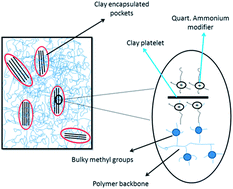Rheological behaviour of clay incorporated natural rubber and chlorobutyl rubber nanocomposites
Abstract
The rheological behaviour of organoclay nanocomposites based on natural rubber (NR) and chlorine substituted isobutyl-isoprene rubber (CIIR), was investigated separately. For the study, an organoclay Nanomer I.44P treated with a surfactant containing hydrogenated tallow, quaternary ammonium chloride, was used. The linear dynamic viscoelastic measurements indicated that the viscosity of NR/organoclay nanocomposites increased as the nanofiller content increases from 0 to 10 phr. NR nanocomposites showed the network formation, however, real solid like behaviour was not observed as reported in the case of other polymer/clay nanocomposites. The extent of exfoliation of nanofillers in NR nanocomposites was estimated using their shear thinning behaviour. Form factor calculations based on TEM data indicated excellent dispersion of clay in the NR matrix. The modeling of the linear dynamic viscoelasticity in NR nanocomposites has been done using the Carreau–Yasuda model (CY model). Interestingly, the behaviour of CIIR nanocomposites was very different from NR nanocomposites. CIIR/organoclay nanocomposites did not show any variation in the viscosity as the filler loading varies from 0 to 10 phr. Viscosity and modulus plots as a function of frequency with varying clay content coalesced into a master curve indicating lack of interaction between clay and CIIR matrix. This has been explained based on polarity mismatch, steric effects and high viscosity of CIIR as compared to NR. The WAXD and TEM analyses showed an intercalated and agglomerated morphology for CIIR/clay nanocomposites. The behaviour of CIIR nanocomposites in this study has been explained by suggesting a different mechanism, where nanofillers are encapsulated in certain “pockets”. The mechanism proposed on CIIR nanocomposites is supported with the help of transmission electron microscopy (TEM).


 Please wait while we load your content...
Please wait while we load your content...